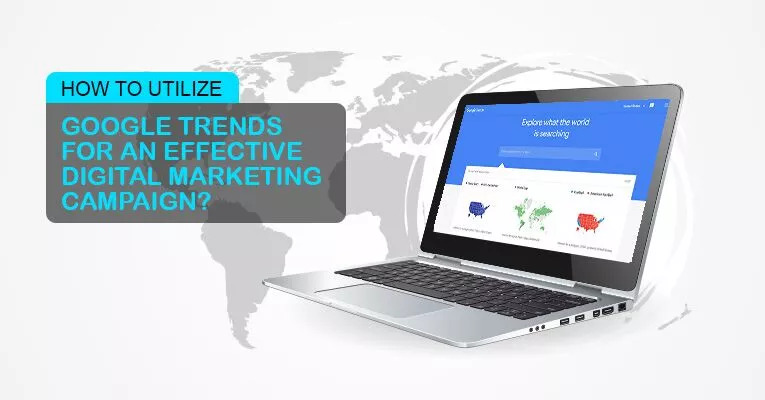Small business owners should always keep up with the free marketing tools at their disposal. If you use a digital marketing agency, their job is to unveil and leverage the mysteries behind tools like Google Trends. However, you can use them too. Unfortunately, often free marketing tools can be difficult to understand without the assistance of an SEO agency. But fear not! Here we explain how you can use Google Trends to better understand trending topics to improve your digital marketing campaigns.
Why Use Google Trends?
Google Trends is your window into search marketing trends allowing you to become more strategic with your SEO and campaigns. When you consider your ongoing challenge to find new and exciting topics for your content, small business owners have an unexpected hat to wear — that of the journalist. To create new content and effective campaigns, you have to keep up with industry trends to help establish yourself as an expert in your field.
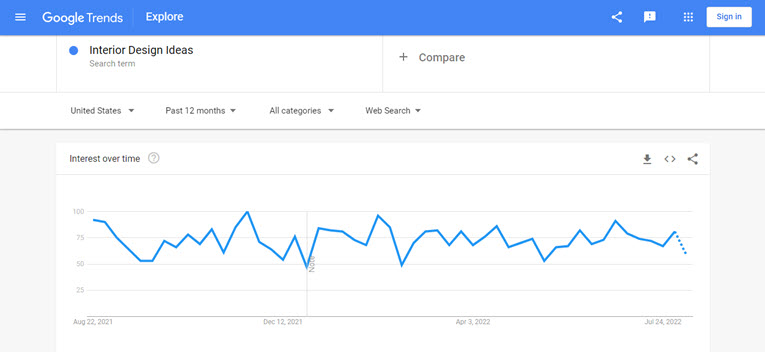
Google Trends was designed as a journalist tool to provide insights into the information that keeps audiences intrigued. What better tool for content creation than one that identifies topics of interest as they become important? When you become better at spotting trends of interest to your audience, you become better at creating content that will attract their attention and, in turn, Google’s. When you understand what popular topics people are searching for, you can create a unique spin on your own content and campaigns to leverage those trends.
How Does Google Trends Work?
The Google Trends search bar allows you to search for a specific topic. Your search results show you a chart with a rating between 0 to 100 to tell you the level of interest in that topic. You see that rating in hand with the times the topic piqued the most interest. You can consider the timing to look for ways to fill in topics on your calendar or simply to understand how often this topic was trending to measure its level of importance to your audience. From there, your campaigns are timed right, and your ad content becomes more relevant.
How to Use Google Trends to Optimize Marketing Strategy
The question now is, how do trends help optimize your marketing strategy? Here are a few ways it helps:
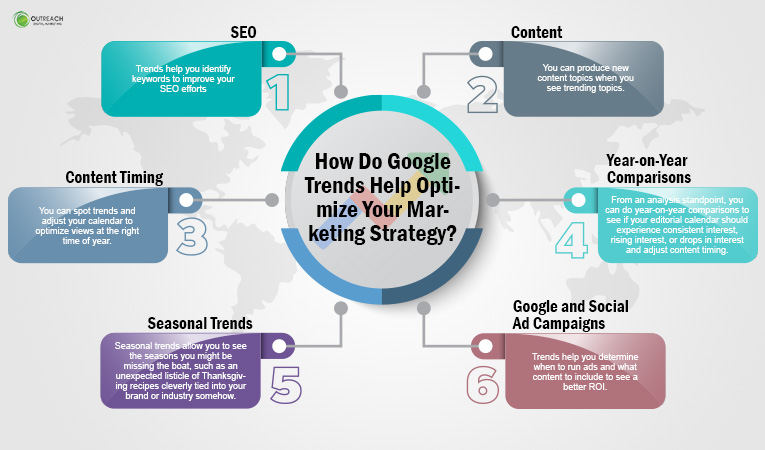
- SEO: Trends help you identify keywords to improve your SEO efforts
- Content: You can produce new content topics when you see trending topics.
- Content Timing: You can spot trends and adjust your calendar to optimize views at the right time of year.
- Year-on-Year Comparisons: From an analysis standpoint, you can do year-on-year comparisons to see if your editorial calendar should experience consistent interest, rising interest, or drops in interest and adjust content timing.
- Seasonal Trends: Seasonal trends allow you to see the seasons you might be missing the boat, such as an unexpected listicle of Thanksgiving recipes cleverly tied into your brand or industry somehow.
- Google and Social Ad Campaigns: Trends help you determine when to run ads and what content to include to see a better ROI.
As you can see, identifying trends touches all aspects of your digital marketing strategy.
Smarter Keywords for Improved SEO
You can improve your content SEO by including trending keywords and the time they trend. Instead of using the same keywords all the time, a more focused approach allows you to leverage trending keywords at certain times of the year to optimize your campaigns based on what people want and when. Understanding trends also allows you to evaluate the content you consider evergreen for your blog.
Is this topic actually seeing a level rate of interest, or is it seeing more peaks and valleys than you’d expect? Or, are there certain topics that maintain an even keel throughout the year and year over year that could provide ideas for more evergreen content? The trends tell you how much fresh, new content you need, and the balance of evergreen content needed to keep a constant drumbeat of knowledge and expertise.
More Engaging and Localized Content
Most companies tend to focus on the same ad content based on the basics of their industry. However, when you use Trending Searches, you can become more engaging with your content creation. Not only do you see the timing for trends, but you develop ideas based on your own location. What is of interest to your community at certain times of the year? How is this different from the entire country?
For example, if you live in Texas, does Blue Bonnet season offer an opportunity to create a unique campaign somehow tied into your industry or brand? Is this the time of year to leverage ads to attract tourists to your area? Factoring in cultural context to become more localized is ideal for a small business owner who depends on local customers.
Create a Calendar Aligned with Peak Time Searches
Getting more precise with your campaign calendar can become much more strategic right down to the day. Google Trends shows you the times and days of the week that make the most sense to publish your content. You can search the topics you have plugged into your calendar and see peak times of the day and days of the week when that particular content seems to be of the most interest. You become much more precise with your calendar to ensure you are showing people what they want when they are most likely to want it, from social posts to emails.
Read Your Brand and Competitions Peak Times
Having a window into the times different brands are searched can provide insight into how well your brand is doing. How is your competition doing? Brand-specific searches allow you to see when people are searching for your brand most often and when that interest declines. Does this coincide with declines in your organic traffic? If so, did anything change in your marketing efforts during these declines? Was anything happening in the industry that could have impacted the decline? Could this be the time of year you should be running Google ads to generate more traffic when organic numbers drop?
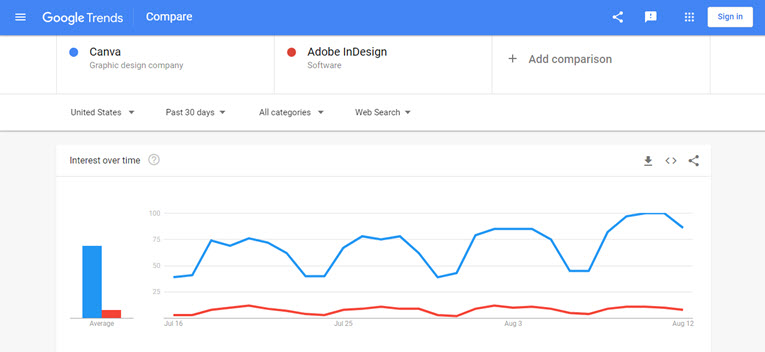
Time Google Campaigns Right
That makes the perfect segue to Google campaigns. Google Trends help you plan the months and times for your Google ads based on dips and rises. If you want to run an ad for chef’s knives, for example, but there tends to be a decline in February and March and interest peaks in September and October, a fall campaign makes the most sense. You leverage the popular search times for the products and services you offer to see a better response and improved ROI per click.
Leveraging Trends and Related Queries
When you identify the types of searches becoming popular, you can become better at being one of the first to leverage that interest. Rising trends are always exciting, as it helps put you in the position as a thought leader as opposed to someone simply hooking your little red wagon to an already established trend. You’re earlier out of the gate, providing the current content of interest to your audience.
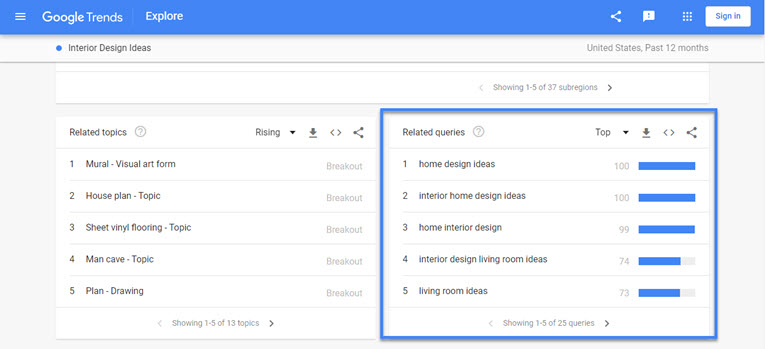
However, you can also make the most of trends by looking at related topics or related queries. This expands the possibilities of the topics you cover in your content and campaigns. Those topics also provide new keywords to consider. Interesting terms like “dark academia” for example, can apply to fashion, as well as interior design. Is there a crossover opportunity here? Sometimes, thinking outside the perimeters, you usually use for topic searches can expand your horizons. As a result, you create far more intriguing and very insightful content for your campaigns.
Avoid Boring Content
You can also pinpoint why certain blogs seem to tank. Search those keywords and topics and see if they tend to show very low interest. Are there related topics or queries you can leverage to rethink that content to repurpose the blog, but with a new twist that includes topics of higher interest? Before you add something to your content or campaign calendar, make sure it’s something of interest, so you don’t waste time on tired topics no one cares about.
Tap Into Your Audience’s Mind
Google Trends allows you to get a better understanding of what your audience likes and dislikes. Visual content, social media, and blog content can all be improved when you understand what your ideal audience is more likely to respond positively to. You generate more attention, improve SEO, and see more click-throughs for your ads. Your landing pages also become more impactful.
Accurately Predict Inventory Numbers Each Season
You can also become better at predicting when to run campaigns and increase inventory numbers throughout the year. Search your products in Google Trends to see when people tend to shop for the products or services you offer. When do the searches start and end? How many are there in your area? These insights are invaluable in helping you identify when you should be running ads and stocking items. You can also get a better idea when you advertise for something like a season sale or get an earlier start on showing off your fall seasonal collections.
Improve Your Social Media Campaigns
Your social media campaigns can also become more effective with Google Trends searches. Related queries are a great way to identify trending topics so you can develop more engaging social ads and posts. Were people searching for an event related to your industry at a certain time of year? Can you use that event to show off your knowledge with product recommendations or service advice? Are there certain seasons people are searching for topics relevant to your industry? Are there links you can post to videos, articles, blog content, etc., that will provide that type of information to followers?
Google Trends allows you to spot the topics that make the most sense to your audience. As a result, you can improve SEO and plan ad campaigns for Google and social more strategically.
If you’re looking for a team to take digital marketing off your plate, Outreach is the team to call!
